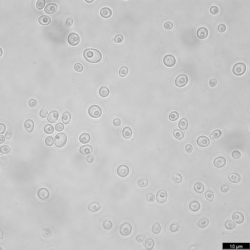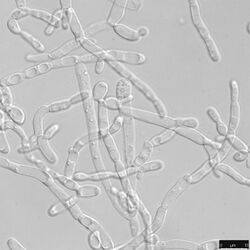Biology:Yarrowia
| Yarrowia | |
|---|---|
| Scientific classification | |
| Kingdom: | |
| Division: | |
| Class: | |
| Order: | |
| Family: | |
| Genus: | Yarrowia Van der Walt & Arx (1981)[1]
|
| Type species | |
| Yarrowia lipolytica (Wick., Kurtzman & Herman) Van der Walt & Arx (1980)
| |
| Species | |
|
Yarrowia bubula | |
Yarrowia is a fungal genus in the family Dipodascaceae. For a while the genus was monotypic, containing the single species Yarrowia lipolytica, a yeast that can use unusual carbon sources, such as hydrocarbons.[2] This has made it of interest for use in industrial microbiology, especially for the production of specialty lipids.[3] Molecular phylogenetics analysis has revealed several other species that have since been added to the genus.[4][5][6]
In January 2019, Yarrowia lipolytica yeast biomass was defined by the European Food Safety Authority as a safe novel food – dried and heat‐killed – with the underlying qualifications that it is widespread in nature, present in the typical environment, may be used as food for people over age 3 (3 grams per day for children under age 10, and 6 grams per day for teens and adults), and may be manufactured as a dietary supplement.[7]
Biology
Habitat
Yarrowia lipolytica has been isolated from various locations (e.g. milled corn fiber tailings or Paris sewers[8]). Often these environments contain an excess of lipids, which can be efficiently utilized by Y. lipolytica as a carbon and energy source.[9] This species is strictly aerobic.[10]
Oleaginous yeast
The cells of Y. lipolytica have over 20% fat content, placing it in the group of oleaginous yeasts.[10] Most lipids are stored as triacylglycerids (TAGs). This physiological trait makes this species especially interesting for producing lipid derivates. For example, genetic engineering and process optimization allow it to produce high amounts of eicosapentaenoic acid (EPA).[11]
Dimorphism
Yarrowia lipolytica has dimorphic growth,[10] which means it can grow in two different phenotypes. The usual form of the cells can be described as round and spherical. When exposed to stressful conditions such as temperature, pH, mechanical or osmotic stress,[12] the cell can switch into a filamentous growth form (also see hyphae).
Genome
The genome of Y. lipolytica consists of around 20.5 Mbp (mega base pairs), encodes for over 7000 genes and is distributed on six chromosomes (named A to F) and the mitochondrial DNA (M). Naturally, there are small differences in the length of the genomes of different strain isolates. Usually hemiascomycetous yeast have a low number of introns, but Y. lipolytica is an exception with about 15% of genes containing introns.[13]
References
- ↑ "The yeast genus Yarrowia gen. nov". Antonie van Leeuwenhoek 46 (6): 517–21. 1980. doi:10.1007/bf00394008. PMID 7195185.
- ↑ "Yarrowia lipolytica mutants devoid of pyruvate carboxylase activity show an unusual growth phenotype". Eukaryotic Cell 4 (2): 356–64. February 2005. doi:10.1128/EC.4.2.356-364.2005. PMID 15701798.
- ↑ "Yarrowia lipolytica: A model microorganism used for the production of tailor-made lipids". European Journal of Lipid Science and Technology 112 (6): 639–654. 2010. doi:10.1002/ejlt.200900197.
- ↑ "Comparative physiology of oleaginous species from the Yarrowia clade". PLOS ONE 8 (5): e63356. 2013. doi:10.1371/journal.pone.0063356. PMID 23667605. Bibcode: 2013PLoSO...863356M.
- ↑ "Yarrowia porcina sp. nov. and Yarrowia bubula f.a. sp. nov., two yeast species from meat and river sediment". Antonie van Leeuwenhoek 105 (4): 697–707. April 2014. doi:10.1007/s10482-014-0125-4. PMID 24500004.
- ↑ "Fungal Planet description sheets: 625-715". Persoonia 39: 270–467. December 2017. doi:10.3767/persoonia.2017.39.11. PMID 29503478.
- ↑ EFSA Panel on Nutrition, Novel Foods and Food Allergens (14 February 2019). "Safety of Yarrowia lipolytica yeast biomass as a novel food pursuant to Regulation (EU) 2015/2283". EFSA Journal (European Food Safety Authority) 17 (2): e05594. doi:10.2903/j.efsa.2019.5594. PMID 32626221.
- ↑ Wolf, Klaus (1996). Nonconventional Yeasts in Biotechnology. doi:10.1007/978-3-642-79856-6. ISBN 978-3-642-79858-0. http://dx.doi.org/10.1007/978-3-642-79856-6.
- ↑ Kurtzman, Cletus P. (2011-01-01), Kurtzman, Cletus P.; Fell, Jack W.; Boekhout, Teun, eds., "Chapter 82 - Yarrowia van der Walt & von Arx (1980)" (in en), The Yeasts (Fifth Edition) (London: Elsevier): pp. 927–929, ISBN 978-0-444-52149-1, http://www.sciencedirect.com/science/article/pii/B9780444521491000823, retrieved 2020-06-24
- ↑ 10.0 10.1 10.2 "Yarrowia lipolytica". Yeast 29 (10): 409–18. October 2012. doi:10.1002/yea.2921. PMID 23038056.
- ↑ "Sustainable source of omega-3 eicosapentaenoic acid from metabolically engineered Yarrowia lipolytica: from fundamental research to commercial production". Applied Microbiology and Biotechnology 99 (4): 1599–610. February 2015. doi:10.1007/s00253-014-6318-y. PMID 25567511.
- ↑ "Different effectors of dimorphism in Yarrowia lipolytica". Archives of Microbiology 178 (6): 477–83. December 2002. doi:10.1007/s00203-002-0478-3. PMID 12420169.
- ↑ Mekouar, Meryem; Blanc-Lenfle, Isabelle; Ozanne, Christophe; Da Silva, Corinne; Cruaud, Corinne; Wincker, Patrick; Gaillardin, Claude; Neuvéglise, Cécile (2010-06-23). "Detection and analysis of alternative splicing in Yarrowia lipolytica reveal structural constraints facilitating nonsense-mediated decay of intron-retaining transcripts". Genome Biology 11 (6): R65. doi:10.1186/gb-2010-11-6-r65. ISSN 1474-760X. PMID 20573210.
Wikidata ☰ Q10723443 entry
 |



